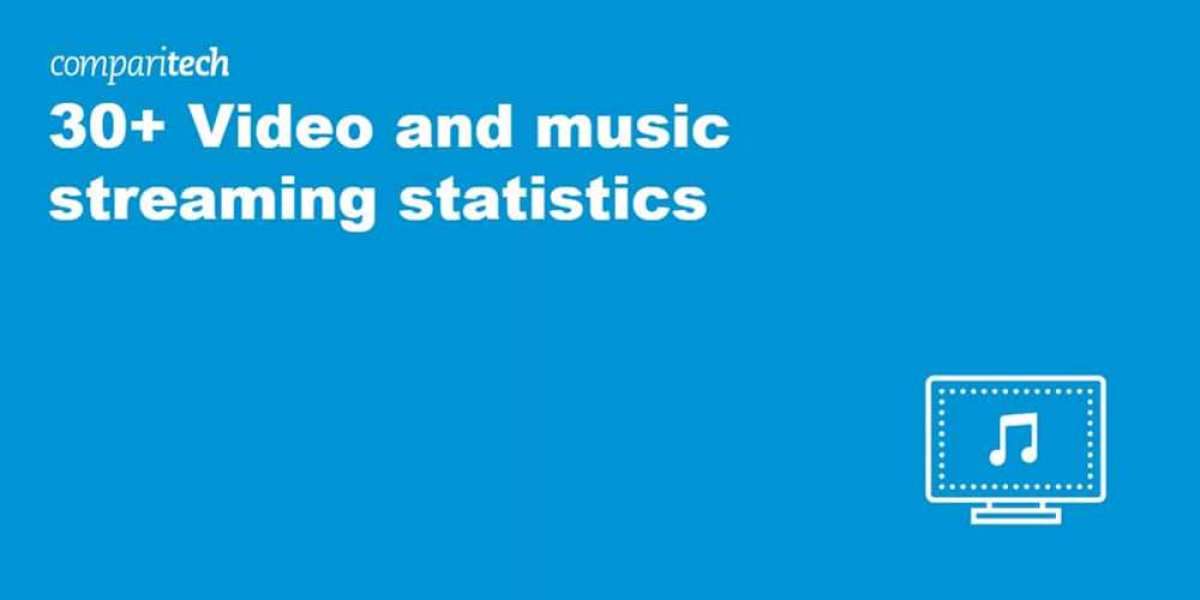Streaming Boom and Market Shift
In recent years, the shift from traditional TV to streaming services for watching shows, movies, sports, and events has become increasingly evident. This trend extends to music as well, with platforms like Spotify and YouTube becoming integral parts of daily entertainment. Streaming services are now available in nearly every country, though their popularity can vary by region.
The rise of streaming is supported by improved internet bandwidth and speeds, making it a more accessible option for consumers worldwide. With this growth, we have access to a wealth of data that helps us understand the evolving landscape of video and music streaming. Here are some key statistics and trends from 2018 to 2024.
Netflix, once the undisputed leader, now faces competition from other providers. For example, Disney+ had over 150 million subscribers by the end of Q4 2023, while Max was close behind with 95 million. Paramount+ also saw significant growth, ending Q3 2023 with approximately 63 million paying subscribers.
Despite the competition, Netflix remains a dominant force. By the end of 2023, Netflix boasted 247.4 million subscribers, with a large portion (83.76 million) located in Europe, the Middle East, and Africa.
Amazon Prime Video is another major player, with over 200 million members. However, since it is bundled with Amazon Prime, it’s difficult to determine the exact number of active streaming users. In China, iQiyi stands out with around 128 million paid subscribers.
YouTube continues to be a powerhouse, with over two billion logged-in users each month. The platform sees more than 30 million daily users watching over a billion hours of video, and its TikTok competitor, YouTube Shorts, garners around 70 billion views per day. Additionally, the YouTube Android app has surpassed 10 billion installs, and the iOS version was among the top 10 most downloaded apps in 2022.
Streaming platforms face a paradox:
more content leads to greater viewer indecision.
Audiences now grapple for over ten minutes daily
simply choosing what to watch on average.
This browsing time has surged by 41%
in just a few short years.
Shockingly, one-fifth of viewers abandon the search entirely
frustrated and opting for other activities.
Amidst this, Disney recalibrates its approach
with content spending set at $25 billion for 2024.
This marks a significant drop from its peak
exceeding $33 billion back in 2022.
Netflix charts a different course
planning $17 billion for original productions
establishing an ambitious benchmark.
Viewers face a dizzying array of choices,
fueled by an ever-expanding universe of streaming platforms.
Free ad-supported television (FAST) accelerates its challenge to paid subscriptions,
a key trend highlighted in Nielsen's 2023 findings.
Pioneered by Pluto TV,
this FAST surge sees major players like Amazon Freevee, Xumo Play, and Plex TV rapidly multiplying in 2024.
Regional access varies dramatically:
US audiences lead with nearly 1,000 free channels,
British viewers tap into 200,
while German users stream over 100.
This overwhelming fragmentation stems directly from the sheer quantity of services,
each offering vast libraries of content.
The cumulative effect?
Subscribers to every possible US platform confront a staggering reality:
access to over 30,000 distinct channels.
The latest report from Comscore reveals a significant surge in streaming, with a 130 percent increase since 2019.
Interestingly, ad-supported platforms are becoming increasingly popular, now accounting for more than one-third of total streaming time.
This trend is expected to continue as providers raise their subscription fees, making ad-supported options even more appealing.
Furthermore, the report indicates that 90 percent of American households currently engage in some form of content streaming, highlighting the widespread adoption of digital entertainment.
Smart TVs dominate streaming device preferences, capturing 74.5% of household viewers.
Streaming sticks hold steady at 64% adoption, showing minimal change over three years.
Gaming consoles surge in popularity, now used by 43.5% of streaming households.
Viewing patterns reveal classics like Grey’s Anatomy attract over half of young adult audiences,
while new releases spark intense but brief interest—Netflix originals filled the entire top ten most-streamed list,
with Outer Banks alone generating 88,000 watch hours. Disney+ dominated 2022’s movie rankings completely
but captured only six top spots in 2023 as Netflix claimed four, led by Glass Onion.
Subscription behaviors reflect economic pressures: 33% canceled services purely to cut costs recently,
mostly switching to ad-supported alternatives rather than downgrading existing plans (just 11%).
Consumers average 2.62 paid subscriptions, yet 50% would cancel if sharing was blocked—only 15% would pay individually.
Younger audiences increasingly adopt binge-and-cancel cycles, likely due to budget constraints.
The market projects explosive growth, forecasted to hit $1.9 trillion by 2030 from $455 billion in 2022,
defying earlier predictions. Netflix responds to cancellations with gaming additions like Into the Breach,
password-sharing fees, and ad-tier expansions. Globally, mobile viewing now leads at 45%,
overtaking PCs which plummeted from 49% to 7% of streaming time in Asia within a year.
TVs follow closely at 43%, while tablets trail at 5%.
Streaming Preferences and Trends
Over a quarter of streaming subscribers prioritize exclusive content access when maintaining subscriptions
Affordable ad-supported tiers emerge as the sole factor outweighing this motivation
Deloitte's research reveals exclusivity serves as a unique draw for 27% of users
This positions proprietary libraries just behind cost-saving options in driving retention decisions
The data underscores how unavailable titles cement platform loyalty beyond price considerations
Original programming and films remain pivotal retention tools in crowded digital markets
The Evolution of Digital Entertainment Consumption: Ad Tolerance, Cost Considerations, and Platform Preferences
Research indicates that advertisement saturation remains a significant pain point in traditional television, with commercials consuming approximately one-third of every viewing hour. Three-quarters of viewers consider this excessive, while over 80% express irritation at repetitive ad content. This advertising fatigue has historically driven consumers toward streaming platforms, with nearly half citing ad-free experiences as a primary motivation for subscription services.
However, economic pressures are reshaping these preferences. As household budgets tighten, consumer attitudes toward advertisements are evolving pragmatically. Recent industry analysis reveals that nearly 60% of users would now accept advertisement interruptions if it resulted in substantial subscription discounts.
The mobile entertainment landscape witnessed a remarkable shift when TikTok dethroned long-standing leader YouTube as the premier entertainment application in 2022. The short-form video platform has achieved unprecedented financial success, becoming only the second application to surpass the $6 billion revenue threshold. Its monetization efficiency is particularly noteworthy, generating approximately $0.85 monthly per U.S. user—a figure that dramatically outperforms competitors like Snapchat, which averages just $0.05 per user.
Viewing habits also demonstrate interesting demographic patterns. Content binging behavior peaks among Millennials and Generation X, with approximately 70% regularly consuming multiple episodes in single sittings. This contrasts sharply with older demographics, as fewer than half of viewers above age 65 engage in similar consumption patterns.
The digital entertainment landscape, particularly in music and video streaming, continues to evolve, reflecting a significant shift in how consumers access and enjoy content. The industry has witnessed an unprecedented boom, with subscription-based services like Spotify and Apple Music becoming the go-to platforms for music enthusiasts. However, it's not just audio that's making waves; video platforms such as YouTube are also major players in the music streaming ecosystem.
A notable milestone was reached on November 25, 2019, when the total number of on-demand audio and video music streams in the U.S. surpassed one trillion for the first time. This figure surged to 1.13 trillion in 2021 and further climbed by 12.2% to reach 1.3 trillion in 2022.
In 2022, on-demand audio song streaming dominated the market, accounting for 1.1 trillion of the total streams, while video streams contributed a substantial 200 billion. This growth is partly fueled by the continuous influx of new music, with streaming services adding approximately 120,000 new tracks daily, up from 93,400 in 2022.
According to the 2022 IFPI report, the global music industry experienced a 9% increase, marking its eighth consecutive year of growth. Specifically, music streaming services saw a 10.3% rise in users.
A 2022 study by IFPI highlighted that Gen Z and Millennials are the primary subscribers to music streaming services. However, older generations are also embracing this trend. Notably, more than a quarter of individuals aged 55 to 64 reported streaming music within the last month, indicating a broadening user base across different age groups.
Global Music Streaming Trends
Global music streaming adoption reveals unexpected generational patterns
US baby boomers emerge as surprising enthusiasts at 90% usage
This contrasts sharply with Japan's 34% adoption among those over 56
Globally, just 56% of this age group typically streams music
Sweden dominates paid subscriptions with 56% of listeners choosing premium
Close behind are the UK (52%), USA (51%), Germany (51%) and Mexico (50%)
Listeners prioritize three key benefits in these services
Ad-free experiences top their preference lists
Followed by on-demand song selection
And extensive music libraries
Generation Z leads overall streaming engagement globally
Over 75% use these platforms regardless of location
The premium model's appeal continues growing worldwide
Reflecting streaming's transformation into mainstream entertainment consumption
Spotify commands global streaming dominance
capturing over 30% of all music subscriptions
Apple Music and Tencent Music closely trail
claiming 13.7% and 13.4% market shares respectively
Monthly active Spotify users exceed half a billion
with 210 million premium subscribers demonstrating
40% conversion to paid plans
Miley Cyrus' "Flowers" soared as 2023's top track
accumulating 1.6 billion streams
while SZA's "Kill Bill" and Harry Styles' "As It Was"
maintained strong streaming momentum
Game platforms emerge as crucial discovery channels
49% of listeners find new music through gaming
evidenced by Minecraft and Undertale soundtracks
approaching one billion Spotify streams combined
Bad Bunny's "Un Verano Sin Ti" dominated albums
racking up 4.5 billion streams in 2023 alone
Drake leads decade-long streaming with 36.3 billion plays
surpassing Post Malone and Eminem significantly
Regional genre preferences reveal fascinating diversity:
US embraces Motown
Japan consumes anime soundtracks
Canada explores goregrind
UK revives shoegaze
Indian listeners average 25.7 weekly music hours
Piracy remains concerning
33% globally access music illegally
rising to 43% among under-24 audiences
Streaming giants aggressively innovate:
Spotify acquired audiobook platform Findaway
launched AI-powered DJ features
Apple Music enhanced time-synced lyrics
Amazon included music in Prime benefits
With 500+ genres available
and relentless platform competition
even market leaders cannot afford stagnation
as listener alternatives multiply continuously
What is a Netflix VPN and How to Get One
A Netflix VPN is a tool that enables viewers to bypass geographical restrictions and access a broader range of content on the platform. By connecting to servers in various countries, users can unlock movies and shows that are typically restricted to specific regions, enhancing their streaming experience.
Why Choose SafeShell as Your Netflix VPN?
If you're encountering a Netflix vpn not working issue due to outdated software failing to bypass restrictions, consider switching to SafeShell VPN for reliable access to region-locked content.
SafeShell VPN excels with its high-speed servers specifically optimized for Netflix, ensuring smooth, buffer-free HD streaming. You can also connect up to five devices simultaneously across various platforms like Windows, macOS, iOS, Android, and smart TVs, letting everyone in the household enjoy uninterrupted viewing on their preferred device. Furthermore, it delivers lightning-fast speeds without any bandwidth throttling, guaranteeing a premium streaming experience.
Beyond performance, SafeShell VPN prioritizes your security with its proprietary "ShellGuard" protocol and top-level encryption, safeguarding your privacy while accessing global libraries. To experience these benefits firsthand, take advantage of SafeShell VPN's flexible free trial plan.
A Step-by-Step Guide to Watch Netflix with SafeShell VPN
To use SafeShell Netflix VPN, follow these steps:
- First, head over to the SafeShell VPN website and subscribe to a plan that suits your needs.
- Next, download and install the SafeShell VPN app on your device, whether it's a Windows PC, macOS, iOS, or Android.
- Once installed, open the SafeShell VPN app and log in with your account credentials.
- After logging in, choose the APP mode for an optimized Netflix streaming experience.
- Browse the list of available servers and select one located in the region whose Netflix content you want to access, such as the US, UK, or Canada.
- Click on "Connect" to establish a secure connection to the chosen server.
- Finally, open the Netflix app or visit the Netflix website, log in with your Netflix account, and start enjoying the content from the selected region.








